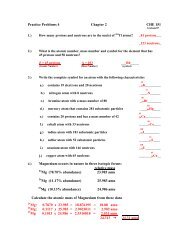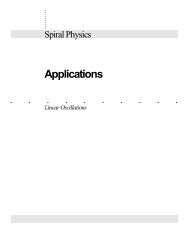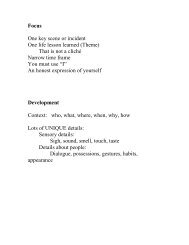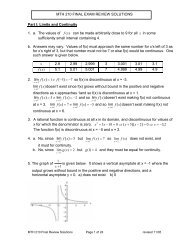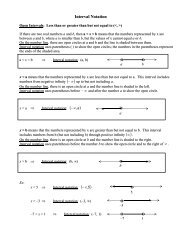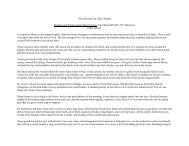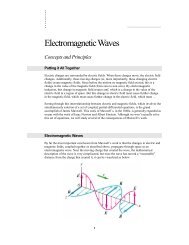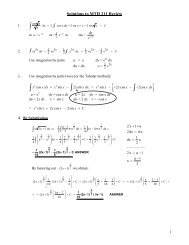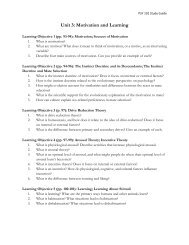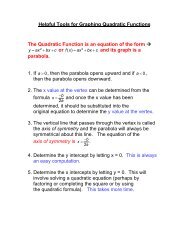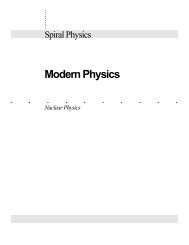Some Notes on Form and Function of the Line and Line Endings in ...
Some Notes on Form and Function of the Line and Line Endings in ...
Some Notes on Form and Function of the Line and Line Endings in ...
You also want an ePaper? Increase the reach of your titles
YUMPU automatically turns print PDFs into web optimized ePapers that Google loves.
We are not lovers.<br />
We do not even know each o<strong>the</strong>r.<br />
We look alike<br />
but we have noth<strong>in</strong>g to say.<br />
We are like pige<strong>on</strong>s . . .<br />
The man <strong>and</strong> wife speak simply, directly though <strong>in</strong> entirely un<strong>in</strong>spired end-stopped sentences or<br />
phrases which dramatize <strong>the</strong> m<strong>on</strong>ot<strong>on</strong>ous, rout<strong>in</strong>e aspects <strong>of</strong> <strong>the</strong>ir existence.<br />
<str<strong>on</strong>g>Some</str<strong>on</strong>g>times an end-stopped l<strong>in</strong>e is reflexive, mean<strong>in</strong>g that <strong>the</strong> l<strong>in</strong>e end<strong>in</strong>g refers to someth<strong>in</strong>g<br />
previously <strong>in</strong> <strong>the</strong> l<strong>in</strong>e <strong>and</strong> <strong>the</strong>refore forces <strong>the</strong> reader to move backward as well as forward (Myers<br />
<strong>and</strong> Simms 163-64). Here’s a l<strong>in</strong>e from a poem by Richard Hugo:<br />
My eyes were like this photo. Old.<br />
Note that <strong>the</strong> l<strong>in</strong>e has been end-stopped, <strong>and</strong> <strong>the</strong>refore closed, but reflexivity forces <strong>the</strong> reader to<br />
move <strong>in</strong> two directi<strong>on</strong>s. “Old” will <strong>on</strong>ly make sense if <strong>the</strong> reader l<strong>in</strong>ks it with <strong>in</strong>formati<strong>on</strong> that<br />
preceded it—eyes <strong>and</strong> <strong>the</strong> photo. Likewise, <strong>the</strong> eyes become old <strong>on</strong>ly when <strong>the</strong> reader has<br />
reached <strong>the</strong> end <strong>of</strong> <strong>the</strong> l<strong>in</strong>e, <strong>the</strong>reby forc<strong>in</strong>g <strong>on</strong>e to return to <strong>the</strong> <strong>in</strong>itial reference <strong>and</strong> create a new<br />
associati<strong>on</strong>: eyes/old.<br />
In <strong>the</strong> case <strong>of</strong> <strong>the</strong> enjambed l<strong>in</strong>e, a l<strong>in</strong>e end<strong>in</strong>g is not stopped at <strong>the</strong> end <strong>of</strong> a sentence or<br />
grammatically complete phrase. Instead, <strong>the</strong> sentence or phrase carries over <strong>in</strong>to <strong>the</strong> next l<strong>in</strong>e.<br />
Here is a group <strong>of</strong> enjambed l<strong>in</strong>es <strong>in</strong> a poem called “A Small S<strong>on</strong>g,” by A. R. Amm<strong>on</strong>s:<br />
The reeds give<br />
way to <strong>the</strong><br />
w<strong>in</strong>d <strong>and</strong> give<br />
<strong>the</strong> w<strong>in</strong>d away.<br />
All four l<strong>in</strong>es <strong>of</strong> this little poem could have been arranged <strong>on</strong> <strong>on</strong>e l<strong>in</strong>e, but <strong>the</strong> effect would have<br />
been different.<br />
The reeds give way to <strong>the</strong> w<strong>in</strong>d <strong>and</strong> give <strong>the</strong> w<strong>in</strong>d away.<br />
8



